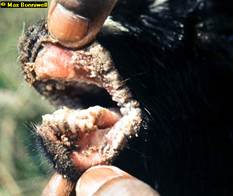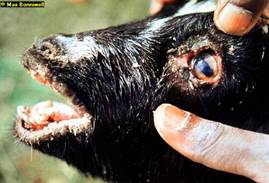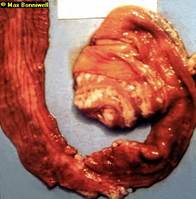Peste Des Petits Ruminants (PPR) (Goat and Sheep)
Description
Peste des Petits Ruminants, otherwise known as Goat Plague or Pseudo-rinderpest, is an acute or subacute viral disease of goats and sheep characterized by fever, erosions and inflammation in the mouth, lips and tongue, gastroenteritis, pneumonia and death.
Goats are primarily affected, sheep less so and cattle are only sub-clinically affected. Humans are not at risk. It can also infect a wide range of other domestic and nondomestic species although little is known about natural patterns of PPR in free-ranging African wildlife.
This is a disease which occurs mainly in the Sahel region of Africa, that area to the south of the Sahara; and the Middle East, to which it was introduced via large importations of goats and sheep from Africa.
A recent outbreak (2008) in north-west Kenya, entering via the Sudan, devastated many flocks of goats and sheep, which, not having encountered the disease before, suffered very high mortality.
Distribution
The disease was first identified in West Africa in the 1940s, PPR is now widespread across much of sub-Saharan Africa. High rates of death from PPR can have dramatic economic consequences, especially in rural African communities whose livelihoods rely on small ruminant livestock production.
PPR was first confirmed in Tanzania in 2008 in the country’s northern regions. However, the virus, which was introduced into Tanzania by southward spread from neighboring countries, was probably in Tanzania long before official confirmation of the disease
 |
| PPR – infection and ulceration of hard palate combined with erosive stomatitis |
|
(c) Max Bonivel
|
 |
| PPR in goat: Pus discharges from nose and eye |
|
(c) Max Bonivel
|
 |
| PPR in goat: “zebra striping” in intestine |
|
(c) Max Bonivel
|
Cause
The virus of Peste des Petits Ruminants (PPR) is related to that of Rinderpest.
Some nomadic goats and sheep in the West-African Sahel have a high innate resistance to PPR and usually undergo subacute reactions. In East Africa PPR is a killer disease with up to 100 % of goats and up to 50% of sheep dying from the infection!
Mode of Spread
This is by close contact. Confinement favours outbreaks.
Secretions and excretions from sick animals are the sources of infection. New infections are initiated when the virus is inhaled by in-contact goats or sheep. The virus enters the new host through the cells of the upper respiratory tract and the conjunctivae.
Signs of PPR
- Mortality in East African goats ranges from 77% to more than 90% and death usually occurs within a week of the onset of the disease.
- An incubation period of 2-6 days is followed, in the acute form, by a sudden rise in body temperature to 40-41.3 degrees C.
- Affected animals appear ill and restless, have a dull coat, dry muzzle, congested mucous membranes and a depressed appetite.
- There is a clear nasal discharge which soon becomes filled with pus with an unpleasant smell. There may be sneezing.
- The discharge from the nose and eyes encrusts the nose and matts the eyelids.
- Severe destructive inflammation affects the lower lip and gums and the tissues where the lower front teeth are inserted into the gum are also similarly severely affected
- In more severe cases it may involve the dental pad, palate, cheeks and their papillae and the tongue.
- There is intense depression and diarrhoea may be very heavy.
- There is dehydration, hypothermia, followed by death, usually after 5 -10 days.
- Bronchopneumonia with coughing often develops in the latter stages of the disease.
The disease is less severe in sheep and sub-acute reactions are more common than in goats, manifested by nasal catarrh, low grade fever, recurring crops of mucosal erosions and intermittent diarrhoea. Most recover after a course of 10 – 14 days.
PPR may affect the immune system of the animals so that more complications arise. The most common activated complication is Pasteurella pneumonia, but other latent infections may also be activated. Orf lesions of the lip, for example, commonly develop in surviving goats.
Diagnosis
The following signs in goats and sheep point the way towards a diagnosis. Confirmation requires laboratory analysis of blood (also lymph nodes and tonsils).
- The carcase is dehydrated and soiled with foetid, fluid faeces.
- Muco-purulent discharges encrust the nose and eyes.
- Necrotic lesions are seen inside the lower lip and on the adjacent gum, the inside of the cheeks and on the lower surface of the tongue. The erosions are shallow, with a red, raw base, which later becomes a pinkish white with a sharp edge.
- Often there is purulent bronchopneumonia
Diseases with similar symptoms
Differential diagnosis includes Heartwater, Contagious Caprine Pleuropneumonia, and Nairobi Sheep Disease.
Treatment and Control
There is no specific treatment, which must therefore be symptomatic and supportive.
The veterinary authorities must be notified at once of any symptoms in goats and sheep suggestive of PPR. Immediate control by restriction of movement of susceptible animals and vaccination is essential, using PPR vaccine. Sick animals should be immediately isolated and contact animals vaccinated. In the event of an outbreak regulation of markets and movement is vital in the mechanics of control.
